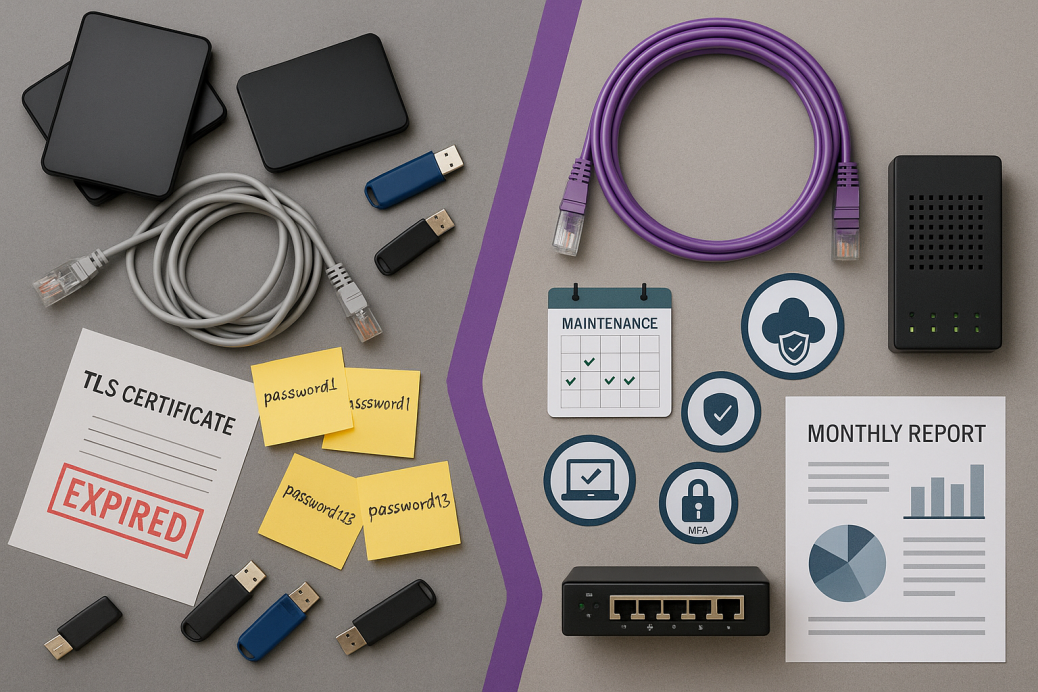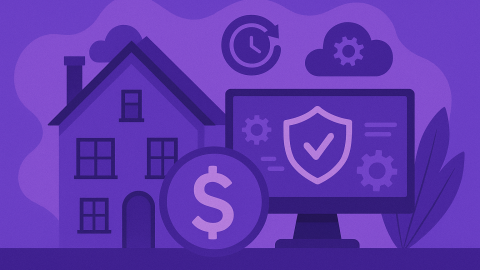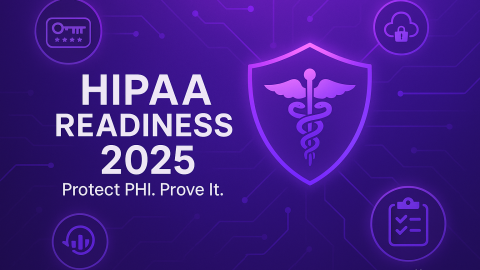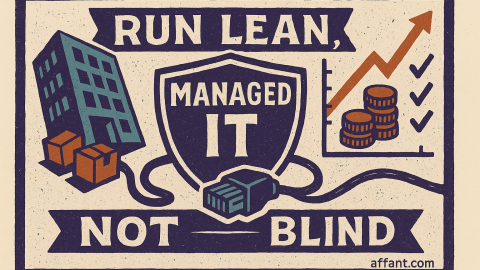Myth 1: “We’re too small for managed IT.”
Reality: ISPs, SaaS outages, and attackers don’t check headcount. Your users expect the same uptime as a Fortune 500.
What it costs: Micro-outages that never hit a P&L: dropped calls, abandoned carts, re-entered forms, frustrated staff. Add the hidden expense of ad-hoc contractors when something breaks after hours.
Do this: Scope a co-managed model. Keep desk-side support in-house; outsource 24×7 monitoring, patching, backups, and security. You’ll cover the graveyard shift without adding headcount.
Myth 2: “Cloud means we don’t need backups.”
Reality: Cloud providers protect availability of their platform; you own recoverability of your data. Versioning and recycle bins are not immutable backups.
What it costs: Ransomware or OAuth-abusing apps that encrypt or purge cloud files, plus long discovery time during audits when you can’t prove retention.
Do this: Add immutable, tenant-separate backups for Microsoft 365/Google and critical SaaS. Test a mailbox and SharePoint restore quarterly; keep screenshots as evidence.
Myth 3: “Alerts = monitoring.”
Reality: Alert emails no one triages at 2 a.m. are not monitoring; they’re noise. Value arrives when a human isolates a sick endpoint or fails over a link before users notice.
What it costs: Missed early warnings—disks filling, certs expiring, fans failing—turn into daytime outages and rushed fixes.
Do this: Route device health, logs, and endpoint telemetry into a system watched by a live NOC/SOC. Define an escalation tree and maintenance windows in a runbook everyone can see.
Myth 4: “Patching breaks stuff, so we wait.”
Reality: Unpatched systems break businesses—usually on the worst day. The fix is not “patch less,” it’s “patch with a process.”
What it costs: Emergency weekends, exploit-driven incidents, and insurance penalties for missing “critical within 30 days.”
Do this: Pilot → roll out → verify → report. Keep a 10-device pilot ring that mirrors production, a standing maintenance window, and a tested rollback. Track time-to-remediate and success rate.
Myth 5: “Our generalist has it covered.”
Reality: No one person can be network engineer, identity admin, security analyst, cloud architect, and after-hours responder forever. PTO and turnover are real.
What it costs: Burnout, “tribal knowledge” risk, and consultant premiums when that key person is out.
Do this: Move commodity tasks—monitoring, patching, backup health, basic security—to a provider with coverage. Your generalist focuses on projects and vendor wrangling.
Myth 6: “We can’t outsource because our environment is quirky.”
Reality: Every environment is quirky. The pattern is the same: document the quirks, wrap them in guardrails, and standardize everything else.
What it costs: Delayed upgrades, brittle integrations, and outsized outage risk around one or two legacy systems.
Do this: Segment the “can’t-patch” boxes, lock down who can reach them, and set vendor-approved maintenance windows. Everything around them follows the normal schedule.
Myth 7: “Managed IT is just renting tools.”
Reality: Tools matter, but the muscle is process and people—especially at 2 a.m. A portal full of red dots doesn’t isolate a device or open a carrier ticket.
What it costs: Paying twice: once for software you don’t fully use and again for emergencies the software didn’t prevent.
Do this: Buy outcomes, not agents. Ask providers to show last month’s mean-time-to-respond, patch success rate, and documented restores for a client your size.
Myth 8: “We’ll lose control.”
Reality: You set the guardrails. A good partner works inside your change windows and approvals and leaves you with the documentation.
What it costs: If this fear blocks outsourcing, you keep absorbing hidden downtime and adrenaline-driven fixes.
Do this: Co-author the runbook: who approves which changes, what can auto-remediate, what requires a thumbs-up, and who gets called when. Review it quarterly.
Myth 9: “We can insource later without pain.”
Reality: You can—if you plan for it. Without clear documents and exportable configs, you’re locked in.
What it costs: Surprise “extraction” projects and lost history when you pivot.
Do this: Put it in the contract: network diagrams, configuration exports, vaulted credentials, and historical logs belong to you and must be delivered on request.
Myth 10: “If something really bad happens, insurance will cover it.”
Reality: Carriers now ask for proof of MFA, logging, immutable backups, and patch cadence. Miss two controls and payouts shrink or premiums jump.
What it costs: Higher deductibles, ransomware sub-limits, and long renewals filled with back-and-forth.
Do this: Treat the provider’s monthly report as your insurance packet: MFA posture, patching timelines, backup test results, and incident logs in one PDF.
Myth 11: “We can’t afford 24×7.”
Reality: You already pay for it—in lost productivity, overtime, and redo work. The question is whether you get anything for that spend.
What it costs: A slow bleed that never shows up on a line item.
Do this: Run a four-week bake-off. Have your current mode and a prospective provider both monitor (read-only) for a week, pilot patches on 10 devices, and perform a mailbox/server restore. Pick the team that gives you the calmest month and the clearest report.
Myth 12: “Dashboards impress leadership.”
Reality: Leaders want fewer interruptions and fewer surprises. Dashboards help; receipts win.
What it costs: Time spent explaining charts instead of showing results.
Do this: Report three numbers every month:
- Time to remediate high-risk items,
- Coverage (percent of devices patched & backed up),
- User-reported tickets trend.
Add one page of notable fixes/outages and next-month priorities.
What “good” looks like after 90 days
- Fewer tickets: especially around Wi-Fi, sign-ins, and the 9 a.m. SaaS rush.
- Routine patching: pilot ring green, fleet green, rollback rarely used but tested.
- Backups with receipts: quarterly restore screenshots and integrity checks.
- Quieter meetings: fewer “why did this break?” conversations; more “what can we improve next?”
- Cleaner renewals: customer security questionnaires and cyber-insurance done in days, not weeks.
If you don’t see these by the end of quarter one, your provider owes you a plan—or you owe yourself a different provider.
Buying checklist (use this in your next call)
- Who answers alerts at 2 a.m.—a person or a queue?
- Can I review the runbook before go-live and after incidents?
- Show last month’s patch success rate, MTTR, and a completed restore.
- Are diagrams, configs, and vaulted credentials exportable on request?
- What’s the pilot/rollback process for risky updates?
- Will you manage third-party app updates (browsers, Zoom, Java), not just OS patches?
Where Affant fits
Affant delivers the boring kind of IT: the kind you don’t think about. We bring a 24×7 NOC + SOC, proactive care on a calendar (patching, backups, cert renewals, capacity checks), integrated tooling you don’t have to buy, and plain-English reporting leaders can skim. We’re comfortable co-managed: your team handles desk-side and projects; we keep watch and keep receipts.
Want proof with your own data? We’ll run a quick health check—read-only discovery, a small patch pilot, and a restore test—and show exactly where proactive care will pay for itself.











